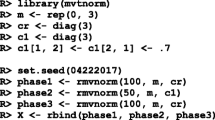Abstract
Time Domain Averaging (TDA) is a traditional (though powerful) method of extracting periodic signals from a composite signal, based on averaging signal sections of the period chosen. The TDA method has been widely used for the condition monitoring of rotating machinery as a pre-process. However, the averaging process requires the measured data to be recorded, and thus may not be easily implemented as a real-time (or on-line) processor. This paper presents an alternative method of performing the TDA that can easily be realized as a real-time averaging processor by using the Kalman filter. The suggested method has another advantage over the traditional TDA method, which is to monitor the variance reduction continuously as the averaging process evolves. This may help to determine whether the averaging is further needed or not. The method is verified by using both simulated data and a measured signal.
Similar content being viewed by others
Abbreviations
- A :
-
matrix of the state model
- H :
-
matrix of the measurement function
- K k :
-
Kalman gain matrix
- P k :
-
error covariance matrix
- Q :
-
process noise covariance matrix
- R :
-
measurement noise covariance matrix
- v k :
-
process noise vector
- w k :
-
measurement noise vector
- x k :
-
state vector at the k-th state
- f p :
-
Fundamental frequency
- M :
-
Number of segments
- N :
-
number of elements in each segment
References
Braun, S., “The Extraction of Periodic waveforms by time domain averaging,” Acustica, Vol. 32, No. 2, pp. 69–77, 1975.
McFadden, P. D., “A revised model for the extraction of periodic waveforms by time domain averaging,” Mech. Syst. Sig. Process., Vol. 1, No. 1, pp. 83–95, 1987.
Dalpiaz, G., Rivola, A. and Rubini, R., “Effectiveness and sensitivity of vibration processing techniques for local fault detection in gears,” Mech. Syst. Sig. Process., Vol. 14, No. 3, pp. 387–412, 2000.
Braun, S. and Seth, B., “On the extraction and filtering of signals acquired from rotating machines,” J. Sound Vib., Vol. 65, No. 1, pp. 37–50, 1979.
Braun, S. and Seth, B., “Analysis of repetitive mechanism signatures,” J. Sound Vib., Vol. 70, No. 4, pp. 513–526, 1980.
Kim, J. K. and Lee, M. C., “Real-time diagnostic system using acoustic emission for a cylinder liner in a large two-stroke diesel engine,” Int. J. Precis. Eng. Manuf., Vol. 10, No. 3, pp. 51–58, 2009.
Kim, H. M., Park, S. H., Lee, J. M. and Kim, J. S., “A robust control of electro hydrostatic actuator using the adaptive backstepping scheme and fuzzy neural networks,” Int. J. Precis. Eng. Manuf., Vol. 11, No. 2, pp. 227–236, 2010.
McFadden, P. D., “Examination of a technique for the early detection of failure in gears by signal processing of the time domain average of the meshing vibration,” Mech. Syst. Sig. Process., Vol. 1, No. 2, pp. 173–183, 1987.
McFadden, P. D., “Interpolation techniques for time domain averaging of gear vibration,” Mech. Syst. Sig. Process., Vol. 3 No. 1, pp. 87–97, 1989.
McFadden, P. D. and Toozhy, M. M., “Application of synchronous averaging to vibration monitoring of rolling element bearings,” Mech. Syst. Sig. Process., Vol. 14, No. 6, pp. 891–906, 2000.
Lee, S. K. and White, P. R., “The Enhancement of Impulsive Noise and Vibration Signals for Fault Detection in Rotating and Reciprocating Machinery,” J. Sound Vib., Vol. 217, No. 3, pp. 485–505, 1998.
Welch, G. and Bishop, G., “An Introduction to Kalman filter,” http://www.cs.unc.edu/~welch/kalman/kalmanIntro.html.
Brown, R. G. and Hwang, P. Y. C., “Introduction to Random Signals and Applied Kalman Filtering, Third Edition,” John Wiley & Sons, 1996.
Author information
Authors and Affiliations
Corresponding author
Rights and permissions
About this article
Cite this article
Shin, K. Realization of the real-time time domain averaging method using the Kalman filter. Int. J. Precis. Eng. Manuf. 12, 413–418 (2011). https://doi.org/10.1007/s12541-011-0053-4
Received:
Accepted:
Published:
Issue Date:
DOI: https://doi.org/10.1007/s12541-011-0053-4




